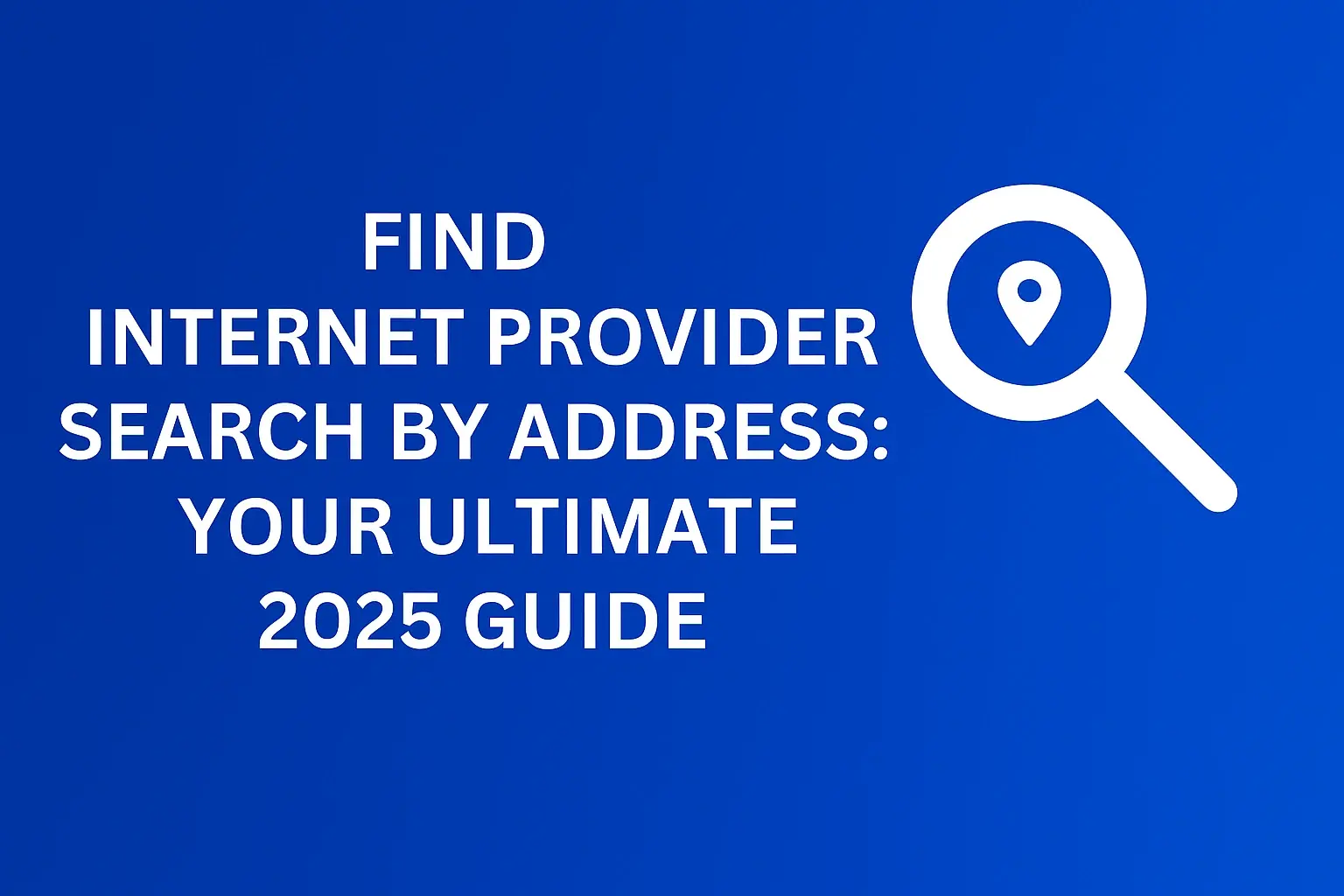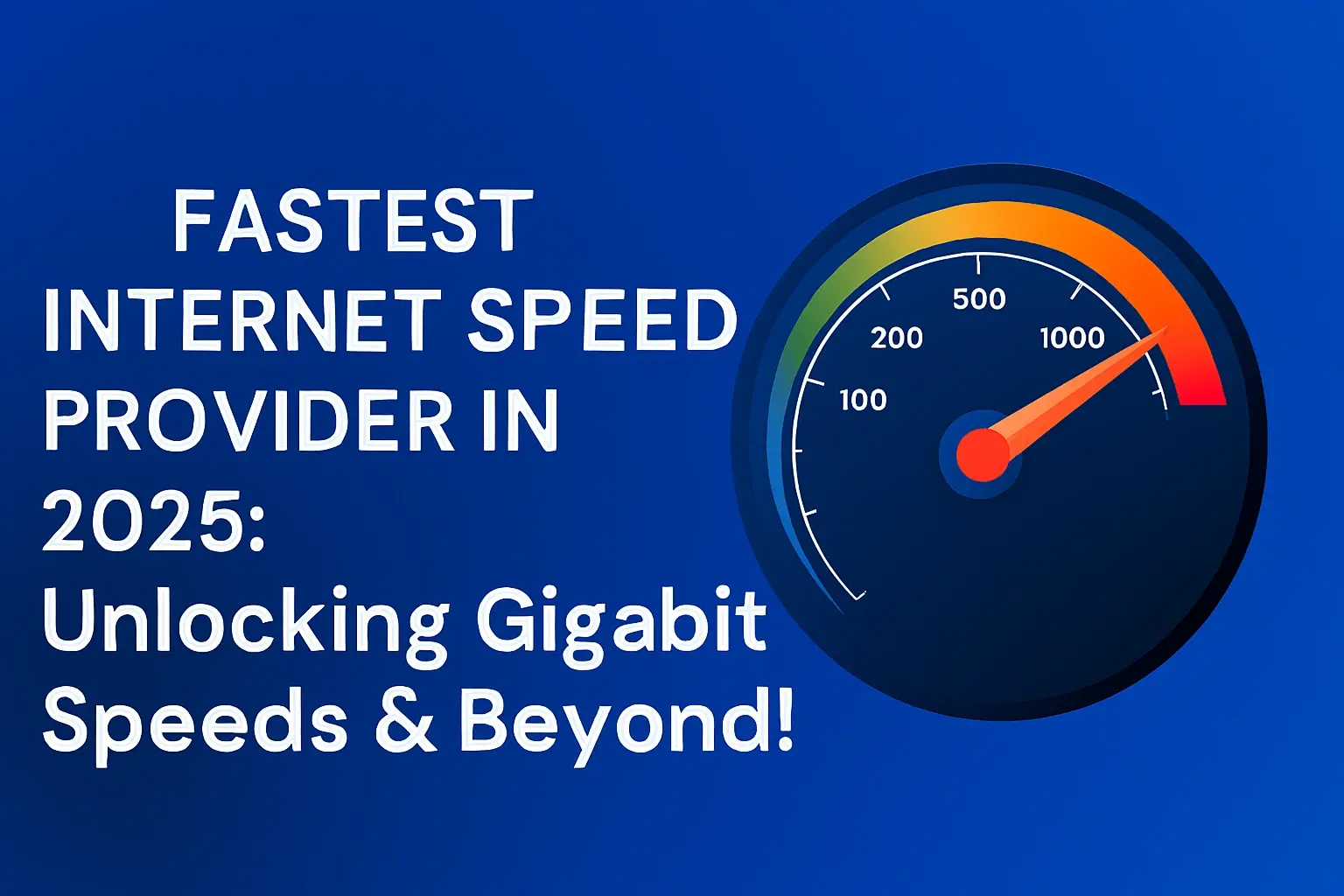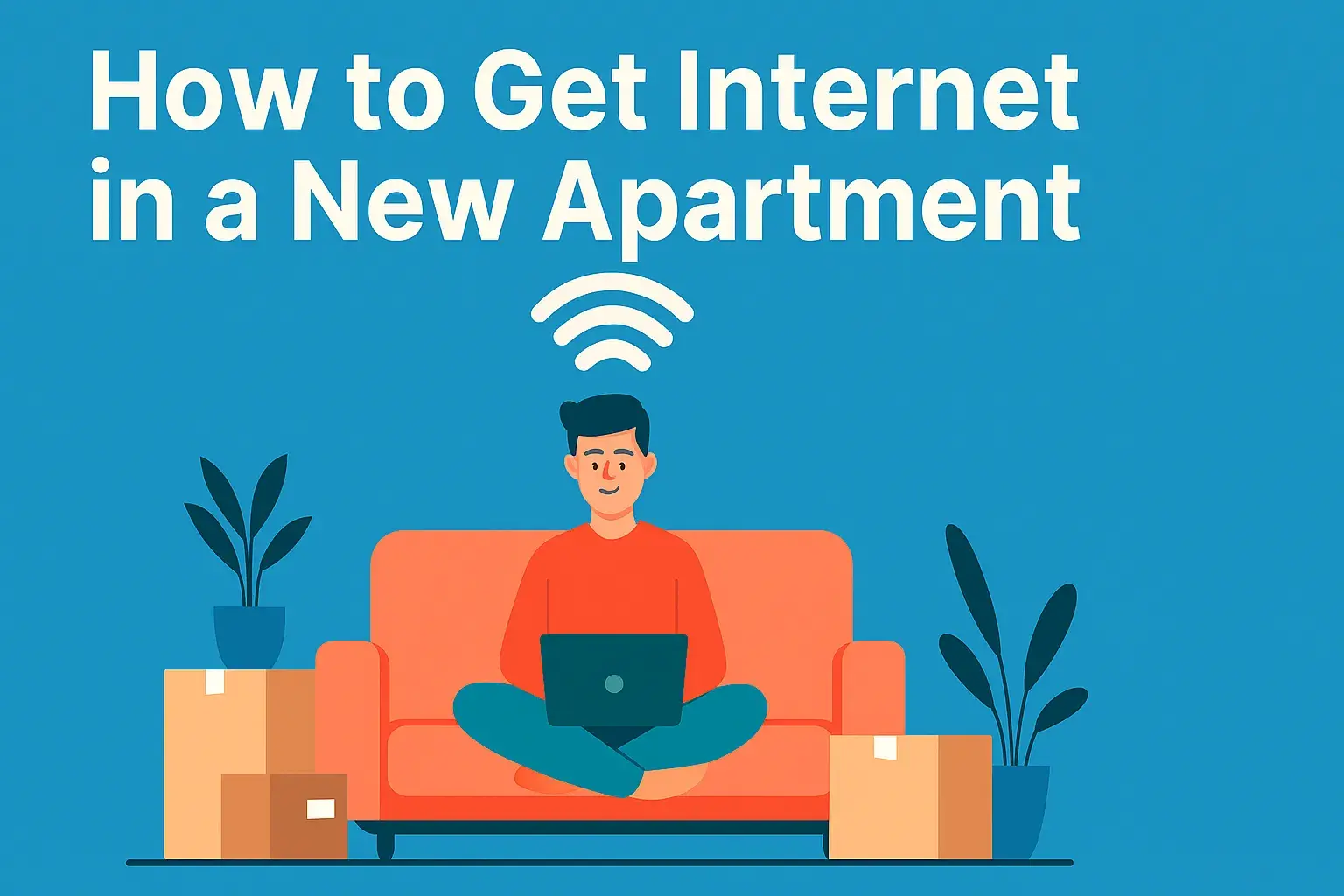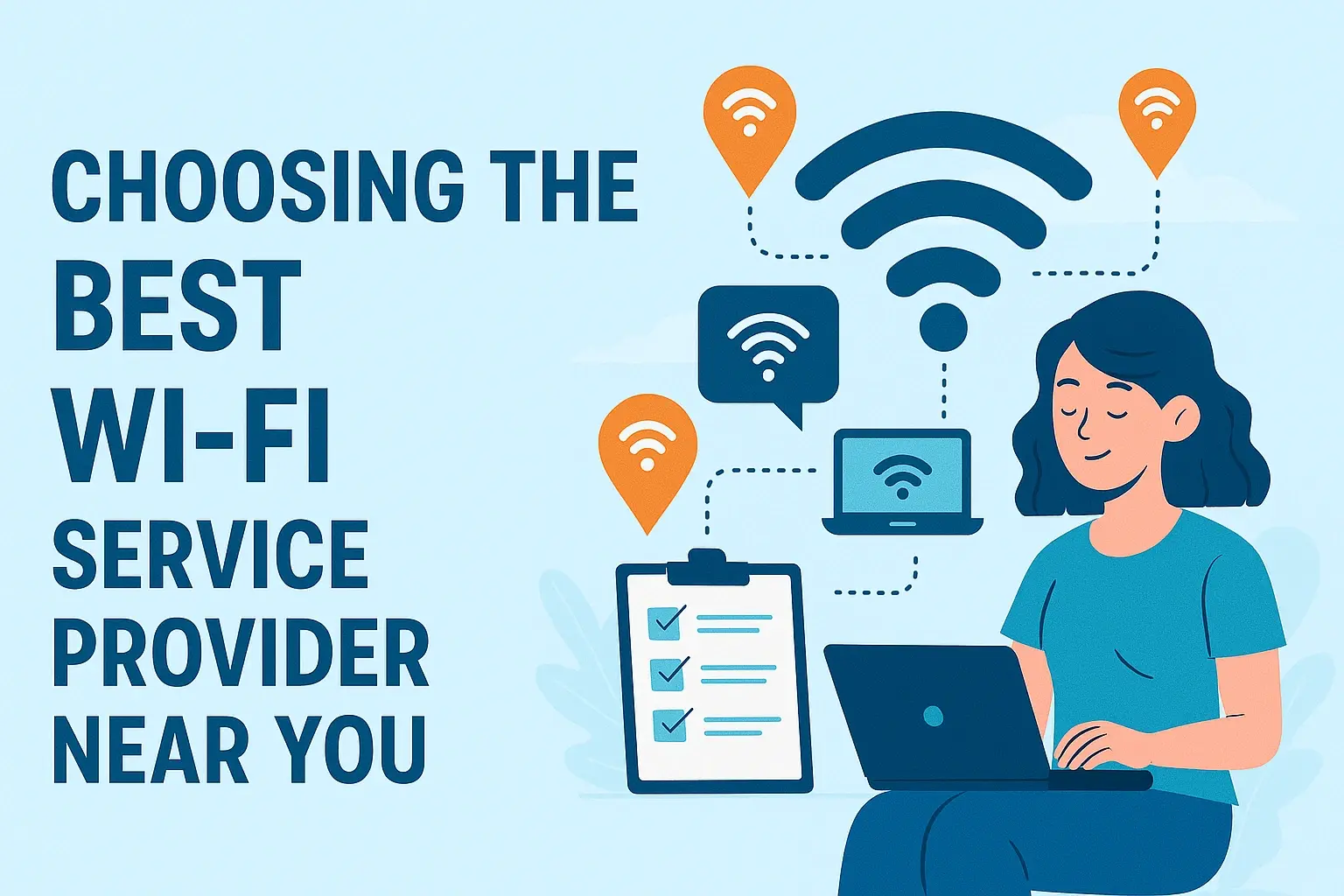Internet Providers Near Me and Why You Need a New One?

Struggling with slow internet or unreliable service? This guide helps you find the best internet providers near you and reveals why upgrading your current plan is essential for modern digital life in 2025. Discover the benefits of faster speeds and improved connectivity.
Finding Internet Providers Near You: Your Comprehensive Guide
In today's hyper-connected world, a reliable internet connection isn't a luxury; it's a necessity. Whether you're working from home, streaming your favorite shows, gaming online, or simply staying in touch with loved ones, your internet service provider (ISP) plays a pivotal role. The phrase "internet providers near me" is one of the most common searches, reflecting a widespread need to identify and secure the best possible service in one's immediate geographic area. This guide is designed to demystify the process, equipping you with the knowledge to not only find available providers but also to understand why a new one might be your best next step.
The Importance of Localized Internet Service Search
The landscape of internet service availability is highly localized. What's available and optimal in one neighborhood might be entirely different just a few miles away. Factors like existing infrastructure, local competition, and even geographical terrain can dictate which types of internet service are offered and at what speeds. Therefore, a targeted search for "internet providers near me" is the most effective starting point. This approach ensures you're focusing on services that can actually be delivered to your doorstep, rather than wasting time researching options that are geographically inaccessible.
Leveraging Online Tools and Resources
The digital age has made finding local services easier than ever. Numerous online platforms and tools are specifically designed to help consumers pinpoint internet providers in their area. These tools typically work by asking for your address or zip code and then cross-referencing this information with a database of known ISP offerings. Some of the most popular and effective resources include:
- ISP Comparison Websites: These sites aggregate information from various providers, allowing you to compare speeds, pricing, contract terms, and customer reviews side-by-side. Examples include BroadbandNow, HighSpeedInternet.com, and Cable.com.
- Provider-Specific Websites: While less comprehensive for comparison, visiting the websites of major ISPs (like Xfinity, Spectrum, Verizon Fios, AT&T Fiber, etc.) and using their address lookup tools can directly show you what they offer at your location.
- Consumer Review Sites: Platforms like Yelp, Google Reviews, and the Better Business Bureau can offer insights into customer satisfaction with local ISPs, though they may not always be exhaustive regarding service availability.
- Local Government Resources: In some areas, local government websites or public utility commissions may provide information on broadband availability and providers.
Understanding Availability and Technology Types
As you search, you'll quickly notice that not all providers offer the same types of internet technology. The technology available at your address will significantly influence the speed, reliability, and cost of your internet service. Common types include:
- DSL (Digital Subscriber Line): Uses existing telephone lines. Generally the slowest option, but widely available.
- Cable Internet: Delivered via coaxial cables, often shared with cable TV. Offers moderate to high speeds and is widely available in urban and suburban areas.
- Fiber Optic Internet: Uses light signals transmitted through glass fibers. Offers the fastest and most reliable speeds, but availability is still limited, primarily in newer developments or specific urban areas.
- Satellite Internet: Beamed from satellites to a dish at your home. Available almost anywhere, but often suffers from higher latency, lower speeds, and data caps.
- Fixed Wireless Internet: Uses radio waves to connect a fixed location to a nearby tower. Can be a good option in rural areas where other services are scarce.
Your search for "internet providers near me" will likely reveal a mix of these technologies. Fiber optic is the gold standard for speed and reliability, but cable and even advanced DSL can be perfectly adequate for many users. Satellite and fixed wireless are often last resorts for those in remote locations.
Why You Absolutely Need a New Internet Provider in 2025
The digital demands of 2025 are vastly different from even a few years ago. With the proliferation of 4K streaming, cloud-based applications, remote work becoming standard, and the increasing number of connected smart home devices, an outdated or underperforming internet connection can significantly hinder your daily life. If your current internet service is causing frustration, it's time to consider an upgrade. Here are compelling reasons why you might need a new internet provider:
1. Inadequate Speeds for Modern Demands
The average internet speed required for a smooth online experience has dramatically increased. In 2025, a household with multiple users and devices will likely need download speeds of at least 100 Mbps, and often much more, to handle simultaneous activities like video conferencing, streaming, and gaming without buffering or lag. If your current plan offers speeds below this threshold, or if you're experiencing slowdowns during peak hours, it's a clear sign you need to look for a provider offering higher bandwidth.
2025 Statistics Snapshot:
- Average household internet speed demand in the US is projected to exceed 150 Mbps.
- 4K streaming alone can consume up to 25 Mbps per stream.
- Remote work often requires stable upload speeds of 20-50 Mbps for seamless video conferencing and file sharing.
2. Unreliable and Intermittent Service
Frequent disconnections, dropped calls, or websites that won't load are not just annoying; they can be detrimental to productivity and leisure. If your current ISP consistently fails to provide a stable connection, it might be due to aging infrastructure, network congestion in your area, or issues specific to their service. A new provider, especially one utilizing newer technologies like fiber optics, can offer significantly improved reliability.
3. Escalating Costs for Subpar Service
It's common for introductory offers to expire, leading to price hikes for your existing internet service. If you find yourself paying more each month for a service that isn't meeting your needs, it's time to re-evaluate. Shopping around for new providers often reveals better deals, introductory promotions, and plans that offer superior value for money. Don't be afraid to switch if you're being overcharged for poor performance.
4. The Rise of Smart Home Technology
Smart home devices, from thermostats and security cameras to smart speakers and lighting, are becoming increasingly popular. Each of these devices connects to your home network, consuming bandwidth and requiring a stable connection. A weak or overloaded internet connection can lead to these devices malfunctioning or becoming unresponsive, diminishing the convenience they are meant to provide. A robust internet plan is essential to support a growing ecosystem of connected devices.
5. Improved Online Gaming and Entertainment Experiences
For gamers, low latency (ping) and high download/upload speeds are critical for a competitive and enjoyable experience. Lag can mean the difference between winning and losing. Similarly, for entertainment enthusiasts, buffering during streaming or slow download times for games and movies can be a major deterrent. Newer internet technologies offer the low latency and high bandwidth needed to fully immerse yourself in online gaming and high-definition entertainment.
6. Essential for Remote Work and Education
The shift towards remote work and online education has made a reliable, high-speed internet connection indispensable. Unstable connections can lead to missed meetings, interrupted lectures, and difficulty accessing critical work or school resources. Investing in a better internet plan is an investment in your professional and educational success.
7. Access to Advanced Features and Bundles
Newer providers or upgraded plans often come with advanced features like mesh Wi-Fi compatibility, enhanced security protocols, and generous data allowances. Furthermore, bundling internet with other services like TV or mobile can sometimes lead to cost savings and simplified billing. Exploring options with different ISPs can uncover these added benefits.
Understanding the Different Types of Internet Services
Choosing the right internet service starts with understanding the underlying technology. Each type has its own advantages, disadvantages, and typical availability. When you search for "internet providers near me," you'll encounter these options, and knowing their characteristics will help you make an informed decision.
DSL (Digital Subscriber Line)
DSL internet uses the same copper telephone lines that carry your voice calls to transmit data. It's a widely available technology, especially in rural and suburban areas where cable or fiber infrastructure may not be present. Speeds vary significantly based on your distance from the provider's central office; the farther away you are, the slower the connection.
- Pros: Widely available, often more affordable than other options, can use phone line simultaneously with a filter.
- Cons: Generally slower speeds compared to cable or fiber, performance degrades with distance from the central office, upload speeds are typically much lower than download speeds.
- Best for: Light internet users, basic web browsing, email, and occasional standard-definition streaming.
Cable Internet
Cable internet is delivered through the same coaxial cable network that provides cable television. It's a popular choice due to its widespread availability in most urban and suburban areas and its ability to offer higher speeds than DSL. However, cable internet is a shared bandwidth technology, meaning speeds can sometimes slow down during peak usage times when many neighbors are online.
- Pros: Generally faster than DSL, widely available in populated areas, often bundled with TV services.
- Cons: Speeds can fluctuate based on neighborhood usage, upload speeds are often significantly lower than download speeds, potential for slower performance during peak hours.
- Best for: Households with multiple users, HD streaming, online gaming, and moderate downloading/uploading.
Fiber Optic Internet
Fiber optic internet is the most advanced and fastest type of internet service available. It uses thin strands of glass or plastic to transmit data as pulses of light. Fiber offers symmetrical download and upload speeds, incredibly low latency, and superior reliability. However, its availability is still limited, primarily found in newer developments, major metropolitan areas, and through specific providers investing heavily in fiber infrastructure.
- Pros: Extremely fast download and upload speeds (often symmetrical), very low latency, highly reliable and consistent performance, less susceptible to interference.
- Cons: Limited availability, can be more expensive than other options, installation might be more involved.
- Best for: Power users, heavy streamers, competitive online gamers, businesses, households with many connected devices, and those who require the absolute best performance.
Satellite Internet
Satellite internet is delivered via a satellite dish installed at your home, which communicates with a satellite in orbit. This technology is a viable option for individuals living in very remote or rural areas where wired connections are not available. However, it comes with significant drawbacks, including high latency due to the distance the signal travels, slower speeds, and often strict data caps.
- Pros: Available almost anywhere, including remote locations.
- Cons: High latency (ping), slower speeds, data caps, susceptible to weather interference, can be expensive.
- Best for: Those in extremely remote areas with no other options.
Fixed Wireless Internet
Fixed wireless internet uses radio waves to connect a fixed location (like your home) to a nearby tower. It's often deployed in rural or underserved areas where laying cable is cost-prohibitive. It can offer speeds comparable to DSL or cable, but its performance can be affected by line-of-sight obstructions and weather conditions.
- Pros: Can be a good alternative in rural areas, potentially faster than satellite, no physical wires to the home.
- Cons: Requires a clear line of sight to the tower, performance can be affected by weather and obstructions, speeds vary.
- Best for: Rural and suburban areas where other high-speed options are limited.
Key Factors When Choosing an Internet Provider
When you're searching for "internet providers near me," it's easy to get overwhelmed by the options. To make the best choice for your household, consider these crucial factors:
1. Internet Speed (Download and Upload)
This is arguably the most critical factor. Download speed determines how quickly you can receive data (e.g., streaming video, loading web pages), while upload speed dictates how quickly you can send data (e.g., sending emails with attachments, video conferencing, uploading files to cloud storage). In 2025, consider your household's typical usage:
- Basic Use (Browsing, Email): 25-50 Mbps download
- Moderate Use (Streaming HD, Social Media, Light Gaming): 50-100 Mbps download
- Heavy Use (4K Streaming, Multiple Users, Heavy Gaming, Remote Work): 100-500+ Mbps download, with at least 20-50 Mbps upload.
Don't forget upload speeds, especially if you work from home or frequently upload large files.
2. Data Caps and Overage Fees
Some internet plans come with a monthly data allowance. If you exceed this limit, you might face throttled speeds or expensive overage fees. For households that stream a lot of video, download large files, or play online games, unlimited data plans are highly recommended. Most fiber and some cable plans offer unlimited data, while satellite and some DSL plans often have caps.
3. Contract Length and Early Termination Fees (ETFs)
Many ISPs require you to sign a contract, typically for 12 or 24 months. While these contracts can sometimes offer lower introductory pricing, be aware of the early termination fees if you need to break the contract before its term. Some providers offer month-to-month plans without contracts, which provide more flexibility.
4. Pricing and Hidden Fees
Always look beyond the advertised monthly price. Many providers add fees for equipment rental (modem/router), installation, activation, and other miscellaneous charges. Calculate the total cost over the contract period to get a true picture of what you'll be paying. Compare the "all-in" price, not just the promotional rate.
5. Reliability and Uptime
A fast speed is useless if the connection is constantly dropping. Look for ISPs known for their reliability. Customer reviews and independent testing sites can provide insights into a provider's uptime performance. Fiber optic internet is generally the most reliable technology.
6. Customer Service and Support
When issues arise, you'll want a provider with responsive and helpful customer support. Research customer service ratings and read reviews to gauge the quality of support offered by different ISPs in your area.
7. Equipment (Modem/Router)
Some ISPs require you to rent their modem and router, while others allow you to use your own compatible equipment. Renting can add to your monthly bill. If you have your own equipment, ensure it meets the ISP's requirements for speed and technology.
8. Bundling Options
If you also need TV or phone service, check if bundling these services with your internet can lead to savings. However, ensure that the bundled package still meets your internet needs and isn't just a way to lock you into a more expensive overall plan.
Comparing Internet Plans: What to Look For
Once you've identified potential "internet providers near me," the next step is to compare their specific plans. This requires a detailed look at the offerings to ensure you're getting the best value and performance for your needs.
Comparison Table: Example Scenario (2025 Data)
Let's consider a hypothetical scenario for a suburban household in mid-2025. The user needs reliable internet for remote work, 4K streaming, and occasional online gaming.
| Feature | Provider A (Cable) | Provider B (Fiber) | Provider C (DSL) |
|---|---|---|---|
| Advertised Download Speed | 300 Mbps | 1 Gbps (1000 Mbps) | 75 Mbps |
| Advertised Upload Speed | 20 Mbps | 1 Gbps (1000 Mbps) | 10 Mbps |
| Technology | Cable | Fiber Optic | DSL |
| Monthly Price (after 12-month promo) | $75 | $90 | $60 |
| Contract Length | 12 Months | 24 Months | Month-to-Month |
| Data Cap | Unlimited | Unlimited | 1 TB |
| Equipment Rental Fee | $15/month | $10/month | $12/month |
| Installation Fee | $99 (waived with online order) | $150 | $75 |
| Estimated Total Monthly Cost (with rental) | $90 | $100 | $72 |
| Reliability Rating (Hypothetical) | Good | Excellent | Fair |
| Best For | Good all-around performance, moderate budget | Maximum performance, future-proofing, demanding users | Very basic internet needs, budget-conscious users |
Analyzing the Comparison
In this example:
- Provider A (Cable): Offers a solid balance of speed and price. The unlimited data is a plus. The upload speed might be a bottleneck for heavy remote work.
- Provider B (Fiber): While the highest monthly cost and installation fee, the symmetrical 1 Gbps speeds are unparalleled for future-proofing and handling any task. The 24-month contract is a commitment.
- Provider C (DSL): The cheapest option and month-to-month, but the speeds are significantly lower and the 1 TB data cap could be an issue for heavy users.
For the user described (remote work, 4K streaming, gaming), Provider B (Fiber) would be the ideal choice if the budget allows and availability is confirmed. If fiber isn't available or too expensive, Provider A (Cable) would be the next best option, provided the upload speeds are sufficient for their remote work needs.
What to Look for in Plan Details:
- Advertised vs. Actual Speeds: Advertised speeds are often "up to" speeds. Real-world performance can vary.
- Symmetrical Speeds: Essential for uploading large files, video conferencing, and live streaming. Fiber is the only technology that consistently offers symmetrical speeds.
- Promotional Periods: Understand how long the introductory rate lasts and what the price will be afterward.
- Bundled Services: If you bundle, ensure the internet component still meets your needs and isn't compromised for the sake of a package deal.
The Internet Installation Process: What to Expect
Once you've chosen an ISP and plan, the next step is installation. The process can vary depending on the technology and the provider, but here's a general overview:
1. Scheduling the Appointment
After signing up, you'll typically schedule an installation appointment. This is often done online or over the phone. Installation windows can range from a few days to a couple of weeks, depending on demand and your location.
2. Technician Visit
On the scheduled day, a technician will visit your home. They will assess where the internet service needs to be brought into your home and where your modem/router will be located. For fiber installations, this might involve running new cables from the street to your house and through walls.
3. Equipment Setup
The technician will install any necessary equipment, such as an outdoor antenna (for fixed wireless), a satellite dish, or an optical network terminal (ONT) for fiber. They will then connect your modem and router (either provided by the ISP or your own) and ensure it's functioning correctly.
4. Service Activation and Testing
The technician will activate your service and perform speed tests to ensure you're receiving the speeds you're paying for. They will also help you connect your devices to the Wi-Fi network.
5. Post-Installation Check
Before the technician leaves, ensure you understand how to use your new equipment and what to do if you encounter problems. Ask for contact information for technical support.
DIY vs. Professional Installation
In some cases, particularly with DSL or basic cable setups, a self-installation kit might be an option. This can save on installation fees but requires you to set up the equipment yourself. For fiber optic installations, professional installation is almost always required due to the complexity of running new lines.
Troubleshooting Common Internet Problems
Even with the best providers, occasional internet issues can arise. Knowing how to troubleshoot can save you time and frustration.
1. Slow Internet Speeds
- Restart Your Modem and Router: This is the classic first step for a reason. Unplug both devices, wait 30 seconds, and plug them back in, modem first.
- Check Your Plan: Are you actually subscribed to a plan that meets your needs?
- Test Speeds Directly: Connect a computer directly to the modem via Ethernet cable and run a speed test (e.g., Speedtest.net). This bypasses Wi-Fi issues.
- Too Many Devices: If many devices are using the internet simultaneously, it can slow down your connection.
- Wi-Fi Interference: Other electronic devices or physical obstructions can weaken your Wi-Fi signal.
2. Intermittent Connection Drops
- Check Cables: Ensure all cables (coaxial, Ethernet, power) are securely connected and not damaged.
- Router Placement: Ensure your router is in a central location, away from obstructions and other electronics.
- Firmware Updates: Check if your router's firmware is up to date.
- ISP Outage: Check your ISP's website or social media for reported outages in your area.
3. No Internet Connection
- Check Lights on Modem/Router: Look at the indicator lights. Solid lights usually indicate a good connection, while blinking or off lights suggest a problem. Consult your device manual.
- Restart Equipment: As mentioned, a power cycle can often resolve connectivity issues.
- Contact Your ISP: If basic troubleshooting doesn't work, it's time to call their technical support.
4. Wi-Fi Issues
- Signal Strength: If you have dead spots, consider a Wi-Fi extender or a mesh Wi-Fi system.
- Router Overload: If you have too many devices connected, your router might be struggling.
- Channel Congestion: Routers operate on different Wi-Fi channels. Sometimes switching to a less congested channel can improve performance (advanced setting).
The Future of Internet Connectivity and What It Means for You
The internet landscape is constantly evolving. As we look beyond 2025, several trends are shaping the future of connectivity, and understanding them can help you make future-proofing decisions today.
5G Home Internet
While primarily known for mobile devices, 5G technology is increasingly being deployed for home internet services. It offers speeds that can rival cable and even fiber in some areas, with the potential for lower latency and greater flexibility. As 5G networks mature, they will become a more significant competitor to traditional wired broadband.
Increased Fiber Optic Deployment
The demand for higher speeds and lower latency is driving significant investment in fiber optic infrastructure. Many cities and regions are actively expanding their fiber networks, making this superior technology more accessible to a wider population. If fiber is available or coming soon to your area, it's an excellent long-term investment.
Artificial Intelligence (AI) in Network Management
AI is being used to optimize network performance, predict and prevent outages, and manage traffic more efficiently. This can lead to more stable and faster internet experiences for consumers.
The Internet of Things (IoT) Growth
The number of connected devices in our homes and cities will continue to skyrocket. This will place even greater demands on internet bandwidth and reliability, making a robust connection more critical than ever.
By understanding these trends, you can choose an internet provider and plan that not only meets your current needs but also positions you well for the future of digital connectivity. Investing in a high-speed, reliable connection today is an investment in your ability to adapt and thrive in an increasingly digital world.
Conclusion
Navigating the world of "internet providers near me" can seem daunting, but understanding your needs and the available technologies is the key to finding the perfect fit. In 2025, with our reliance on high-speed, stable internet for work, education, and entertainment, settling for subpar service is no longer an option. Whether you're experiencing slow speeds, frequent disconnections, or simply feel you're paying too much for what you get, it's time to explore new options. Prioritize fiber optic internet if available for unparalleled speed and reliability, or consider advanced cable plans for a strong balance. Always compare speeds, data caps, contract terms, and hidden fees to ensure you're getting the best value. Don't hesitate to switch providers to unlock a more seamless and productive digital life. Your internet connection is the backbone of your modern existence; ensure it's as strong and reliable as possible.





